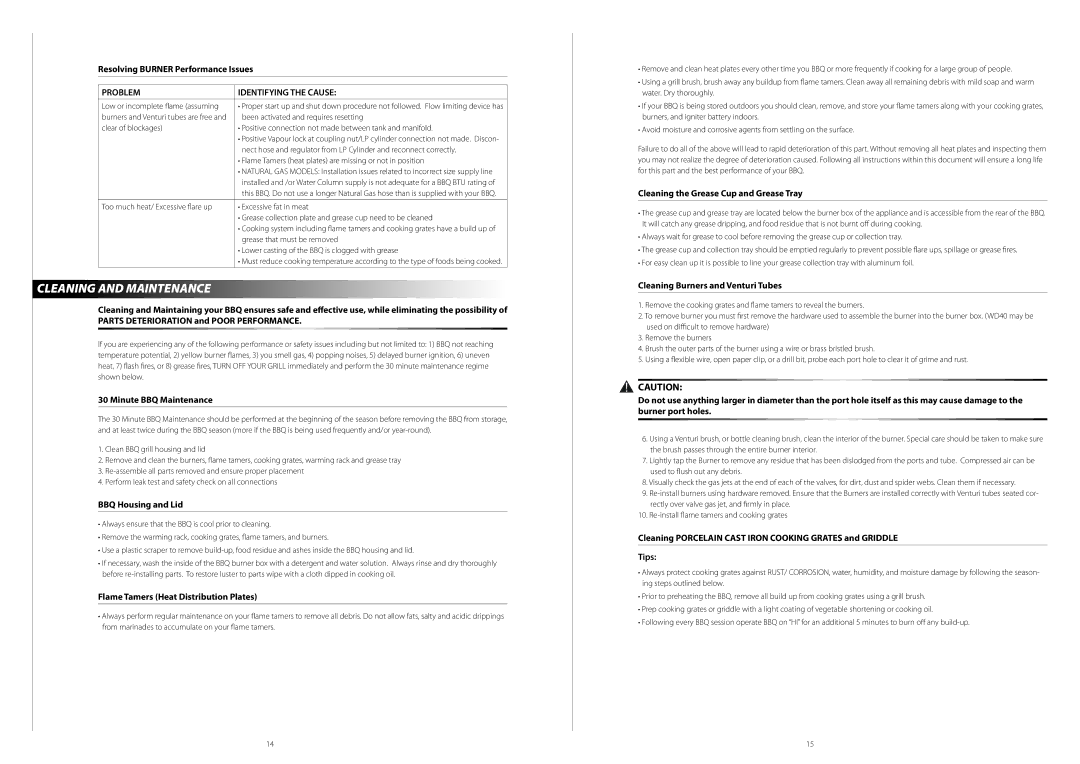
Resolving BURNER Performance Issues
PROBLEM | IDENTIFYING THE CAUSE: |
|
|
Low or incomplete flame (assuming | • Proper start up and shut down procedure not followed. Flow limiting device has |
burners and Venturi tubes are free and | been activated and requires resetting |
clear of blockages) | • Positive connection not made between tank and manifold. |
| • Positive Vapour lock at coupling nut/LP cylinder connection not made. Discon- |
| nect hose and regulator from LP Cylinder and reconnect correctly. |
| • Flame Tamers (heat plates) are missing or not in position |
| • NATURAL GAS MODELS: Installation issues related to incorrect size supply line |
| installed and /or Water Column supply is not adequate for a BBQ BTU rating of |
| this BBQ. Do not use a longer Natural Gas hose than is supplied with your BBQ. |
|
|
Too much heat/ Excessive flare up | • Excessive fat in meat |
| • Grease collection plate and grease cup need to be cleaned |
| • Cooking system including flame tamers and cooking grates have a build up of |
| grease that must be removed |
| • Lower casting of the BBQ is clogged with grease |
| • Must reduce cooking temperature according to the type of foods being cooked. |
|
|
CLEANING AND MAINTENANCE
Cleaning and Maintaining your BBQ ensures safe and effective use, while eliminating the possibility of PARTS DETERIORATION and POOR PERFORMANCE.
If you are experiencing any of the following performance or safety issues including but not limited to: 1) BBQ not reaching temperature potential, 2) yellow burner flames, 3) you smell gas, 4) popping noises, 5) delayed burner ignition, 6) uneven heat, 7) flash fires, or 8) grease fires, TURN OFF YOUR GRILL immediately and perform the 30 minute maintenance regime shown below.
30 Minute BBQ Maintenance
The 30 Minute BBQ Maintenance should be performed at the beginning of the season before removing the BBQ from storage, and at least twice during the BBQ season (more if the BBQ is being used frequently and/or
1.Clean BBQ grill housing and lid
2.Remove and clean the burners, flame tamers, cooking grates, warming rack and grease tray
3.
4.Perform leak test and safety check on all connections
BBQ Housing and Lid
•Always ensure that the BBQ is cool prior to cleaning.
•Remove the warming rack, cooking grates, flame tamers, and burners.
•Use a plastic scraper to remove
•If necessary, wash the inside of the BBQ burner box with a detergent and water solution. Always rinse and dry thoroughly before
Flame Tamers (Heat Distribution Plates)
•Always perform regular maintenance on your flame tamers to remove all debris. Do not allow fats, salty and acidic drippings from marinades to accumulate on your flame tamers.
•Remove and clean heat plates every other time you BBQ or more frequently if cooking for a large group of people.
•Using a grill brush, brush away any buildup from flame tamers. Clean away all remaining debris with mild soap and warm water. Dry thoroughly.
•If your BBQ is being stored outdoors you should clean, remove, and store your flame tamers along with your cooking grates, burners, and igniter battery indoors.
•Avoid moisture and corrosive agents from settling on the surface.
Failure to do all of the above will lead to rapid deterioration of this part. Without removing all heat plates and inspecting them you may not realize the degree of deterioration caused. Following all instructions within this document will ensure a long life for this part and the best performance of your BBQ.
Cleaning the Grease Cup and Grease Tray
•The grease cup and grease tray are located below the burner box of the appliance and is accessible from the rear of the BBQ.
It will catch any grease dripping, and food residue that is not burnt off during cooking.
•Always wait for grease to cool before removing the grease cup or collection tray.
•The grease cup and collection tray should be emptied regularly to prevent possible flare ups, spillage or grease fires.
•For easy clean up it is possible to line your grease collection tray with aluminum foil.
Cleaning Burners and Venturi Tubes
1.Remove the cooking grates and flame tamers to reveal the burners.
2.To remove burner you must first remove the hardware used to assemble the burner into the burner box. (WD40 may be used on difficult to remove hardware)
3.Remove the burners
4.Brush the outer parts of the burner using a wire or brass bristled brush.
5.Using a flexible wire, open paper clip, or a drill bit, probe each port hole to clear it of grime and rust.
![]() CAUTION:
CAUTION:
Do not use anything larger in diameter than the port hole itself as this may cause damage to the burner port holes.
6.Using a Venturi brush, or bottle cleaning brush, clean the interior of the burner. Special care should be taken to make sure the brush passes through the entire burner interior.
7.Lightly tap the Burner to remove any residue that has been dislodged from the ports and tube. Compressed air can be used to flush out any debris.
8.Visually check the gas jets at the end of each of the valves, for dirt, dust and spider webs. Clean them if necessary.
9.
10.
Cleaning PORCELAIN CAST IRON COOKING GRATES and GRIDDLE
Tips:
•Always protect cooking grates against RUST/ CORROSION, water, humidity, and moisture damage by following the season- ing steps outlined below.
•Prior to preheating the BBQ, remove all build up from cooking grates using a grill brush.
•Prep cooking grates or griddle with a light coating of vegetable shortening or cooking oil.
•Following every BBQ session operate BBQ on “HI” for an additional 5 minutes to burn off any
14 | 15 |
